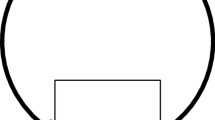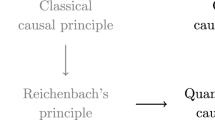Abstract
In this paper, we argue that quantum information theory can provide a kind of non-causal explanation (“causal account” here stands quite generally both for dynamical and for mechanistic account of causal explanation) of quantum entanglement. However, such an explanation per se does not rule out the possibility of a dynamical explanation of the quantum correlations, to be given in terms of some interpretations (or alternative formulations) of quantum theory. In order to strengthen the claim that it can provide an explanation of the quantum correlations, quantum information theory should inquire into the possibility that the quantum correlations could be treated as “natural”, that is, as phenomena that are physically fundamental. As such, they would admit only a structural explanation, similarly to what happened in crucial revolutionary episodes in the history of physics.
Access this chapter
Tax calculation will be finalised at checkout
Purchases are for personal use only
Similar content being viewed by others
Notes
- 1.
Selective measurements operations are here obviously not considered, given that in such operations the statistics in general changes due to a change of the ensemble under study.
- 2.
In the following we follow closely CBH’s and Timpson’s treatments.
- 3.
Part of the results of this section are exposed in more details in (Felline 2016).
- 4.
“We can distinguish various kinds of theories in physics. Most of them are constructive. They attempt to build up a picture of the more complex phenomena out of the materials of a relativity simple formal scheme from which they start out. Along with this most important class of theories there exists a second, which I will call ‘principle-theories.’ These employ the analytic, not synthetic, method. The elements which form their basis and starting-point are not hypothetically constructed but empirically discovered ones, general characteristics of natural processes, principles that give rise to mathematically formulated criteria which the separate processes or the theoretical representations of them have to satisfy” (Einstein 1919, p. 228).
- 5.
The objection that this is really a form of Hempelian derivation will be dealt with below.
- 6.
See note 1.
- 7.
For more details, see Dorato (2014).
References
Bokulich, A. (2009). How scientific models can explain. Synthese, 180(1), 33–45.
Brown, H., & Pooley, O. (2006). Minkowski space-time: A glorious non-entity. In D. Dieks (Ed.), The ontology of Spacetime (pp. 67–89). Amsterdam: Elsevier.
Bub, J. (2000). Quantum mechanics as a principle theory. Studies in the History and Philosophy of Modern Physics, 31B, 75–94.
Bub, J. (2004). Why the quantum? Studies in the History and Philosophy of Modern Physics, 35B, 241–266 arXiv:quant-ph/0402149 v1.
Bub, J. (2005). Quantum theory is about quantum information. Foundations of Physics, 35(4), 541–560 arXiv:quant-ph/0408020 v2.
Bub, J. (2015). Quantum entanglement and information, Edward N. Zalta (ed.). The stanford encyclopedia of philosophy (Summer 2015 Edition). http://plato.stanford.edu/archives/sum2015/entries/QM-entangle/
Clifton, R. (1998). Structural explanation in quantum theory. Eprint: http://philsci-archive.pitt.edu/archive/00000091/00/explanation-in-quantumtheory.pdf, unpublished.
Clifton, R., Bub, J., & Halvorson, H. (2003). Characterizing quantum theory in terms of information theoretic constraints. Foundations of Physics, 33(11), 1561 Page refs. to arXiv:quant-ph/0211089.
Craver, C. F. (2007). Explaining the brain. Oxford: Oxford University Press.
Dorato, M. (2014). Causal versus structural explanations in scientific revolutions. Synthese, 2014, 1–21, https://doi.org/10.1007/s11229-014-0546-7
Dorato, M., & Felline, L. (2011). Scientific explanation and scientific structuralism. In A. Bokulich & P. Bokulich (Eds.), Scientific structuralism (pp. 161–176). Dordrecht: Springer.
Einstein, A. (1919). Time, space, and gravitation. The London Times, November 28. Page references to reprint (under the title: What is the theory of relativity?) In A. Einstein (Ed.), Ideas and ppinions (pp. 227–232). New York: Crown Publishers, 1954.
Flores, F. 1999, “Einstein’s Theory of Theories and Types of Theoretical Explanation”, International Studies in the Philosophy of Science, 13, 2, (pp. 123–134).
Felline, L. (2011). Scientific explanation between principle and constructive theories. Philosophy of Science, 78(5), 989–1000.
Felline, L. (2015). Mechanisms meet structural explanation. Synthese, 1–16.
Felline, L. (2016). It’s a matter of principle: Scientific explanation in information-theoretic reconstructions of quantum theory. Dialectica, 70(4), 549–575.
Felline, L. (2018). Mechanisms meet structural explanation. Synthese, 195(1), 99–114.
Flores, F. (1999). Einstein’s theory of theories and types of theoretical explanation. International Studies in the Philosophy of Science, 13(2), 123–134.
Glennan, S. (2010). Mechanisms, causes, and the layered model of the world. Philosophy and Phenomenological Research, 81(2), 362–381.
Grinbaum, A. (2007). Reconstruction of quantum theory. British Journal for the Philosophy of Science, 58(3), 387–408.
Hagar, A., & Hemmo, M. (2006). Explaining the unobserved—Why quantum mechanics ain’t only about information. Foundations of Physics, 36(9), 1295–1324 Page refs. to http://arxiv.org/abs/quant-ph/0512095.
Hughes, R. I. G. (1989). Bell’s theorem, ideology, and structural explanation. In J. Cushing & E. McMullin (Eds.), Philosophical consequences of quantum theory (pp. 195–207). Indiana: Notre Dame.
Janssen, M. (2002a). Reconsidering a scientific revolution, the case of Einstein versus Lorentz. Physics in Perspective, 4, 421–446.
Janssen, M. (2002b). COI stories: Explanation and evidence in the history of science. Physics in Perspective, 10, 457–520.
Janssen, M. (2009). Drawing the line between kinematics and dynamics in special relativity. In Studies in history and philosophy of modern physics, 40(1) 26–52.
Körner, S. (1969). Fundamental questions of philosophy. Harmondsworth: Penguin Books.
Kuhn, T. (1970). The structure of scientific revolutions (Second Enlarged ed.). Chicago: Chicago University Press.
Lange, M. (2013a). How to explain the Lorentz transformations. In S. Mumford & M. Tugby (Eds.), Metaphysics and science. Oxford: Oxford University Press.
Lange, M. (2013b). What makes a scientific explanation distinctively mathematical? British Journal for the Philosophy of Science, 64, 485–511.
Morrison, M. (1999). Models as autonomous agents. In M. Morgan & M. Morrison (Eds.), Models as mediators: Perspectives on natural and social science (pp. 38–65). Cambridge: Cambridge University Press.
Pincock, C. (2014). Abstract explanations in science. The British Journal for the Philosophy of Science 66(4), 857–882. axu016.
Reutlinger, A. (2012). Getting rid of interventions. Studies in History and Philosophy of Science Part C: Studies in History and Philosophy of Biological and Biomedical Sciences, 43(4), 787–795.
Schrödinger, E., & Born, M. (1935). Discussion of probability relations between separated systems. Mathematical Proceedings of the Cambridge Philosophical Society, 31(4), 555–563.
Steiner, M. (1978). Mathematical explanation. Philosophical Studies, 34(2), 135–151.
Timpson, C. G. (2010). Information, immaterialism, instrumentalism: Old and new in quantum information. In A. Bokulich, G. Jaeger, (Eds.) Philosophy of quantum information and entanglement, 208–227. Cambridge: Cambridge University Press.
Timpson, C. G. (2013). Quantum information theory and the foundations of quantum mechanics. Oxford: Oxford University Press.
Zeilinger, A. (1999). A foundational principle for quantum mechanics. Foundations of Physics, 29(4), 631–643.
Zeilinger, A. (2005). The message of the quantum. Nature, 438, 743.
Author information
Authors and Affiliations
Corresponding author
Editor information
Editors and Affiliations
Rights and permissions
Copyright information
© 2018 Springer International Publishing AG, part of Springer Nature
About this chapter
Cite this chapter
Dorato, M., Felline, L. (2018). On Explaining Non-dynamically the Quantum Correlations Via Quantum Information Theory: What It Takes. In: Hansson, S. (eds) Technology and Mathematics. Philosophy of Engineering and Technology, vol 30. Springer, Cham. https://doi.org/10.1007/978-3-319-93779-3_10
Download citation
DOI: https://doi.org/10.1007/978-3-319-93779-3_10
Published:
Publisher Name: Springer, Cham
Print ISBN: 978-3-319-93778-6
Online ISBN: 978-3-319-93779-3
eBook Packages: Religion and PhilosophyPhilosophy and Religion (R0)




